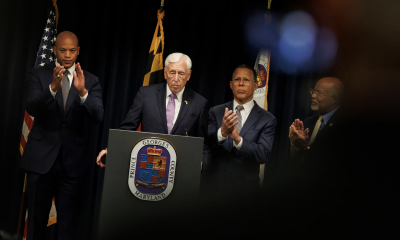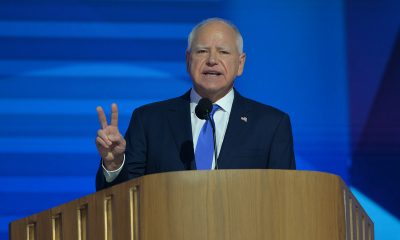a&e features
A newfound appreciation for Columbia at 50
Gen X and Millennial Blade staffers recall formative years in innovative town
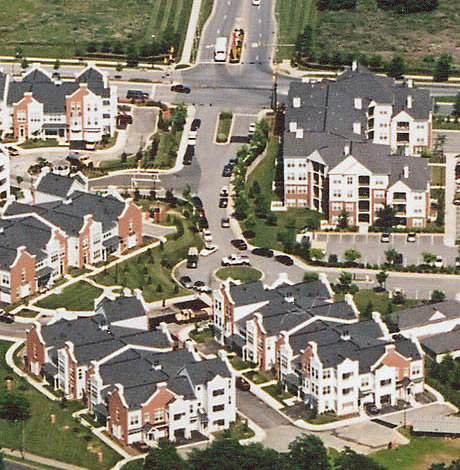
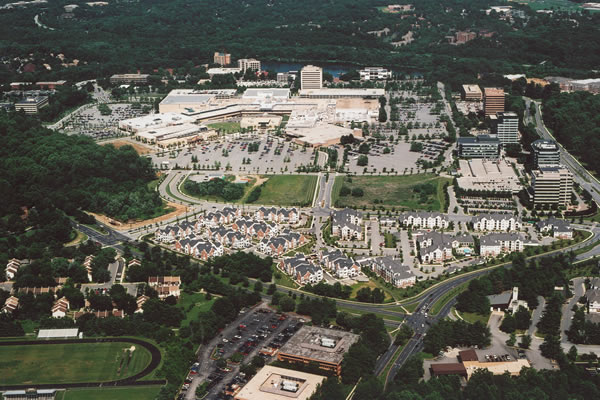
An aerial shot of Columbia, Md., taken in the 1970s. For a list of anniversary activities, visit columbiamd50.com. (Photo courtesy the Columbia Archives)
Growing up as a Columbia ‘pioneer’
By KEVIN NAFF

Blade Editor Kevin Naff in 1970s Columbia. (Photo courtesy of Naff)
The reputation of Columbia, Md., as a racially integrated place was tested early, just after its founding in June 1967.
It was one year later in June of 1968 that segregationist Alabama Gov. George Wallace held a rally at Merriweather Post Pavilion in support of his presidential campaign. New Columbia residents, including some African Americans enticed to move there because of founder James Rouse’s promise of integrated housing, were upset. Some called for the rally to be cancelled.
But not Rouse.
“I am convinced that the fabric of our country is so true that we have the capability of weathering demagogues,” Rouse said, according to the Baltimore Sun. “Only through exposure have they been suffocated.”
Rouse wanted to “capitalize on the contrast between Wallace and Columbia,” the Sun reported at the time. He asked, ”Might not this be a creative experience for Columbia?”
Ultimately, Wallace spoke to a crowd of his Confederate flag-waving supporters, as Columbia residents organized a counter rally across town. The community response — passionate, informed, open — reflects my experience growing up in the new city sandwiched between Baltimore and Washington.
My parents moved to Columbia in 1974; early residents were called “pioneers” lured by Rouse’s grand dream of a new American city that would be a “garden for growing people.” His vision included racial integration during a tumultuous time in the civil rights movement. It included all, regardless of income or social status or religion. In fact, many Columbia residents worshipped in “interfaith centers,” in which a Catholic Mass might be held down the hall from a Jewish service at the same time. Even our mailboxes were designed to bring people together — communal boxes that became daily destinations and places for neighbors to meet.
Rouse’s dream included a deep respect for the environment and an appreciation for fitness and the outdoors. Columbia residents enjoyed access to parks, endless miles of paved bike paths, health clubs, neighborhood swimming pools and more. The town’s schools would be the envy of the country and, to this day, Howard County’s public schools are still ranked among the best.
I edited our monthly newspaper at my high school, Hammond High’s “Bear Press.” We tackled controversial and sensitive subjects like teen suicide. We studied foreign languages, reading French authors in the original text and chatting with foreign exchange students over progressive dinners. It was an academically challenging curriculum, before the days of demonizing education and dismissing curious students as “elitist.” Teachers constantly pushed and challenged us. My teachers at Hammond — Sherry Conklin for English and journalism; Karen Dunlop for French; and Kathleen Nawrocki for government and history — were the best I ever encountered.
There were even a few openly gay and bisexual students, which was brave and rare given the fear and hatred unleashed by the growing AIDS epidemic. When my decidedly alternative friends and I delivered a choreographed performance of “Kung Fu Fighting” at the high school talent show complete with a drag component, no one batted an eye. I graduated from high school in 1988, long before the days of Gay-Straight Alliances.
Still, those of us who grew up in Columbia had friends of all backgrounds from the beginning of first grade — different religions and races and economic situations. Subsidized apartments and upscale single-family homes were built within a stone’s throw of each other. And those streets were named after works of literature, odd names like “Greco Garth” and “Deep Smoke.” Neighborhoods were, in turn, named after the authors behind the street names, hence Longfellow, Dickinson and Hawthorne.
In our cynical times, polluted with the crass cruelty of social media attacks, all of this nostalgia sounds naive and Pollyanna. But it wasn’t that way for those of us who lived it and can now look back and appreciate the laudable goals that Rouse set out for himself and the residents of his city.
Was it perfect? Of course not. But after moving away to attend college at Penn State and encountering a roommate who had never met a black person, I quickly realized how lucky I was to have grown up in Columbia.
As Columbia celebrates 50 years, I hope its current residents remember James Rouse and his vision. As Rouse put it, “the only valid ultimate purpose of any civilization is to grow better people; more creative, more productive, more inspired, more loving people.”
This Millennial realized hometown’s appeal after she left
By RASHANNA LEE
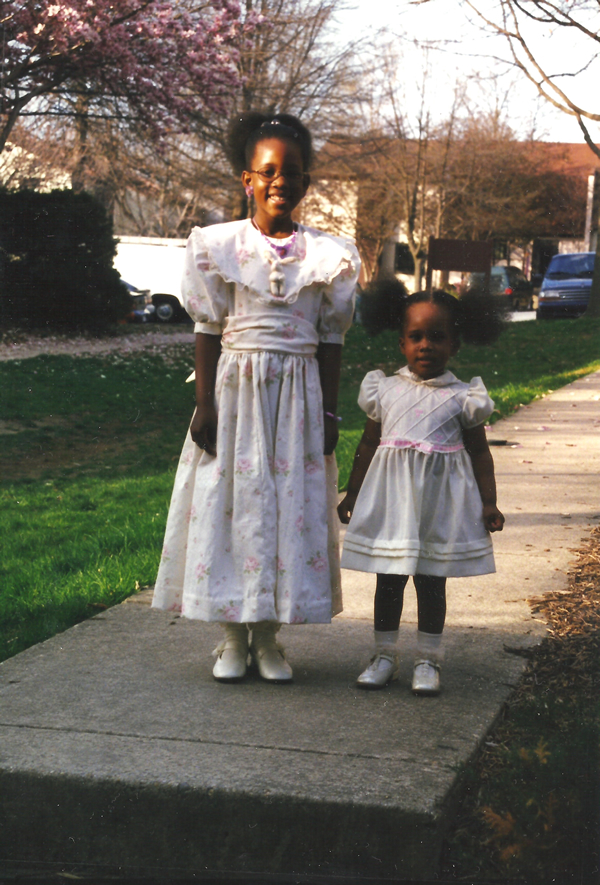
Rashanna Lee (right) with her sister in 1990s Columbia. Lee is a 2017 Blade summer intern in its editorial department. (Photo courtesy of Lee)
My parents moved to Columbia in 1993. My mother had just graduated from Howard University and was expecting my older sister. The choice to raise children in Columbia was a deliberate, and arguably difficult, choice for my parents. My father lived all over the world, but has deep roots in Boston while my mother is from the Bronx.
They struggled between the idea of raising city kids like they were, or taking advantage of the opportunities the suburbs offered. One of the things that Columbia is known for is its school system. My mom was a first-generation college graduate and for that reason she made education the determining factor in where she decided to raise her kids.
When I was young, I wasn’t aware of the history or the notoriety associated with Columbia, but I certainly took advantage of the benefits. My elementary school was Phelps Luck and it was such an enriching and diverse place to get my formative education. I had friends of all races and religions and my teachers were diverse as well. This taught me from an early age about being tolerant and I learned that all people are worthy of respect, regardless of what they look like.
As I moved on to middle and high school, the emphasis on tolerance and respect only intensified. I graduated from Howard High School in 2014 and one of the things that sticks out to me about my high school experience was how nice (generally) everyone was to each other. There were strict, zero-tolerance policies on bullying, and support groups like the Gay-Straight Alliance and black female empowerment groups. The kids weren’t perfect, but I would say we accepted and encouraged individuality at the very least.
My relationship with my hometown, like many relationships, had ups and downs. As I got older, the repetitive and seemingly predictable nature of Columbia combined with classic teen angst caused me to resent the upbringing that my parents worked so hard to give me. I hated the familiar feeling of Columbia. I started going to New York City and exploring D.C. on weekends and I wanted a taste of metropolitan life. I wanted to be edgier.
It wasn’t until the first weekend I came home from college at Penn State in central Pennsylvania that I really valued what I had growing up. I remember getting off Route 100 and feeling relieved that I entered the bubble of familiarity I had grown to hate so much before. As I drove into my neighborhood and saw all the different faces and types of people that were able to exist in such a relatively small city, I was thankful.
When James Rouse founded Columbia in 1967 he had a vision. He wanted Columbia to be a place where people of all religions, races, socioeconomic statuses and ethnicities could live in harmony. As I walk the quiet streets of Columbia I realize that I am proof of the success of his vision. Growing up here has allowed me a certain sensibility and sensitivity that my friends from other towns and cities don’t have or don’t quite understand.
Columbia has grown exponentially since I was growing up. I can remember picking pumpkins and riding horses on various local farms that are now townhouses or shopping centers. Although the size of the city has changed, the spirit of it has not. I see bumper stickers, flags and advertisements for community groups pledging support for people of all walks of life.
As the world has become more open minded and tolerant, so has Columbia. It’s a place that grounds me when my world has become too big and I need to come back down to earth. When I’m home, I see the good in people as it is exemplified in the genial and community-oriented spirits of the people around me. That is a powerful thing.
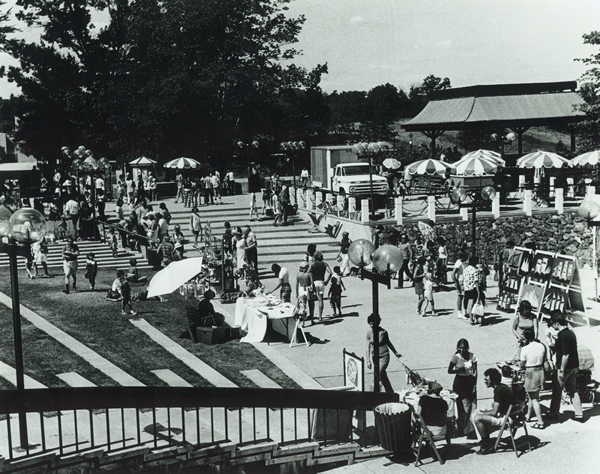
(Photo courtesy of the Columbia Archives)
a&e features
Queer highlights of the 2026 Critics Choice Awards: Aunt Gladys, that ‘Heated Rivalry’ shoutout and more
Amy Madigan’s win in the supporting actress category puts her in serious contention to win the Oscar for ‘Weapons’

From Chelsea Handler shouting out Heated Rivalry in her opening monologue to Amy Madigan proving that horror performances can (and should) be taken seriously, the Critics Choice Awards provided plenty of iconic moments for queer movie fans to celebrate on the long road to Oscar night.
Handler kicked off the ceremony by recapping the biggest moments in pop culture last year, from Wicked: For Good to Sinners. She also made room to joke about the surprise hit TV sensation on everyone’s minds: “Shoutout to Heated Rivalry. Everyone loves it! Gay men love it, women love it, straight men who say they aren’t gay but work out at Equinox love it!”
The back-to-back wins for Jacob Elordi in Frankenstein and Amy Madigan in Weapons are notable, given the horror bias that awards voters typically have. Aunt Gladys instantly became a pop culture phenomenon within the LGBTQ+ community when Zach Cregger’s hit horror comedy released in August, but the thought that Madigan could be a serious awards contender for such a fun, out-there performance seemed improbable to most months ago. Now, considering the sheer amount of critics’ attention she’s received over the past month, there’s no denying she’s in the running for the Oscar.
“I really wasn’t expecting all of this because I thought people would like the movie, and I thought people would dig Gladys, but you love Gladys! I mean, it’s crazy,” Madigan said during her acceptance speech. “I get [sent] makeup tutorials and paintings. I even got one weird thing about how she’s a sex icon also, which I didn’t go too deep into that one.”
Over on the TV side, Rhea Seehorn won in the incredibly competitive best actress in a drama series category for her acclaimed performance as Carol in Pluribus, beating out the likes of Emmy winner Britt Lower for Severance, Carrie Coon for The White Lotus, and Bella Ramsey for The Last of Us. Pluribus, which was created by Breaking Bad’s showrunner Vince Gilligan, has been celebrated by audiences for its rich exploration of queer trauma and conversion therapy.
Jean Smart was Hack’s only win of the night, as Hannah Einbinder couldn’t repeat her Emmy victory in the supporting actress in a comedy series category against Janelle James, who nabbed a trophy for Abbott Elementary. Hacks lost the best comedy series award to The Studio, as it did at the Emmys in September. And in the limited series category, Erin Doherty repeated her Emmy success in supporting actress, joining in yet another Adolescence awards sweep.
As Oscar fans speculate on what these Critics Choice wins mean for future ceremonies, we have next week’s Golden Globes ceremony to look forward to on Jan. 11.
a&e features
Looking back at the 10 biggest A&E stories of 2025
‘Wicked,’ Lady Gaga’s new era, ‘Sexy’ Bailey and more

Although 2025 was a year marked by countless attacks on trans rights and political setbacks, the year also saw brilliant queer artists continuing to create art. From Cannes and Sundance Award winners now vying for Oscar consideration to pop icons entering new stages of their careers, queer people persevered to tell their stories through different media.
With the state of the world so uncertain, perhaps there’s no more vital time to celebrate our wins, as seen through some of this year’s top pop culture moments. While there’s no collection of 10 stories that fully encompass “the most important” news, here are some events that got the gays going:
10. ‘Mysterious Gaze of the Flamingo’ wins big at Cannes

The Cannes Film Festival has become a crucial start for films hoping to make their way to the Oscars, and first-time director Diego Céspedes won the top Un Certain Regard prize for his intimate western “The Mysterious Gaze of the Flamingo.” The film is set in the ‘80s and is intended as an allegory for the AIDS epidemic. Seeing a film that unpacks vital queer history win one of the most coveted awards at Cannes has been a huge point of pride in the independent filmmaking community.
Since the film bowed at Cannes, it has been selected as Chile’s Oscar entry in the Best International Feature race. Speaking with The Blade during the film’s AFI Fest run in October, Céspedes said: At first, I was kind of scared to have this campaign position in the times that we’re living [in] here. But at the same time, I think the Oscars mean a huge platform — a huge platform for art and politics.”
9. ‘The Last of Us’ returns for an even gayer season 2
While the first season of The Last of Us gave us one of TV’s most heartbreaking queer love stories in the episode “Long, Long Time,” Season 2 doubled down on its commitment to queer storytelling with the blossoming relationship between Ellie (Bella Ramsey) and Dina (Isabela Merced). The show expanded on the pair’s relationship in the original video game, making it perhaps the central dynamic to the entire season. That unfortunately came with more homophobic backlash on the internet, but those who checked out all the episodes saw a tender relationship form amid the show’s post-apocalyptic, often violent backdrop. For their performance, Ramsey was once again nominated for an Emmy, but Merced deserved just as much awards attention.
8. ‘Emilia Pérez’ sparks controversy
Jacques Audiard’s genre-bending trans musical “Emilia Pérez” proved to be an awards season juggernaut this time last year, winning the Golden Globe for Best Musical/Comedy. But when the lead star Karla Sofia Gascón’s racist, sexist, and homophobic old tweets resurfaced, the film’s Oscar campaign became a tough sell, especially after Netflix had tried so hard to sell Emilia Pérez as the “progressive” film to vote for. Mind you, the film had already received significant backlash from LGBTQ+ audiences and the Mexican community for its stereotypical and reductive portrayals, but the Gascón controversy made what was originally just social media backlash impossible to ignore. The only person who seemed to come out of the whole debacle unscathed was Zoe Saldaña, who won the Oscar for Best Supporting Actress over Ariana Grande.
7. ‘Sorry, Baby’ establishes Eva Victor as major talent
Back in January at the Sundance Film Festival, Eva Victor (known by many for her brand of sketch comedy) premiered their directorial debut “Sorry, Baby” to rave reviews, even winning the Waldo Salt Screening Award. Victor shadowed Jane Schoenbrun on the set of “I Saw the TV Glow,” and seeing Victor come into their own and establish such a strong voice immediately made them one of independent cinema’s most exciting new voices. A memorable scene in the film sees the main character, Agnes (played by Victor), struggling to check a box for male or female, just one example of how naturally queerness is woven into the fabric of the story.
Most recently, Victor was nominated for a Golden Globe for her performance in the film, and she’s represented in a category alongside Jennifer Lawrence (“Die My Love”), Jessie Buckley (“Hamnet”), Julia Roberts (“After the Hunt”), Renate Reinsve (“Sentimental Value”) and Tessa Thompson (“Hedda”). The film also received four Independent Spirit Award nominations overall.
6. Paul Reubens comes out in posthumous doc

While Paul Reubens never publicly came out as gay before passing away in 2023, the two-part documentary “Pee-wee as Himself” premiered back in May on HBO Max, giving the legendary comedian a chance to posthumously open up to the world. Directed by Matt Wolf, the documentary explores how Reubens found his alter ego Pee-Wee Herman and why he kept his private life private.
The documentary won an Emmy in the Outstanding Documentary or Nonfiction Special category and remains one of the most critically acclaimed titles of the year with a 100% Rotten Tomatoes score. Also worth noting, the National Geographic documentary Sally told the posthumous coming out story of Sally Ride through the help of her long-time partner, Tam O’Shaughnessy.
5. Lady Gaga releases ‘Mayhem’
Lady Gaga entered a new phase of her musical career with the release of Mayhem, her seventh album to date. From the frenzy-inducing pop hit Abracadabra to the memorable Bruno Mars duet featured on “Die With a Smile,” seeing Gaga return to her roots and make an album for the most die-hard of fans was especially rewarding after the underwhelming film releases of “House of Gucci” and “Joker: Folie à Deux.” Gaga has been touring with The Mayhem Ball since July, her first arena tour since 2018. She even extended her tour into 2026 with more North American dates, so the party isn’t stopping anytime soon. And Gaga is even set to make an appearance next May in “The Devil Wears Prada 2.”
4. Cynthia Erivo, Ariana Grande perform at the Oscars

While “Wicked: For Good” didn’t quite reach the heights of the first film, we will forever have Cynthia Erivo and Ariana Grande’s breathtaking live performance that opened the 97th Academy Awards. The pair sang a rendition of “Over the Rainbow,” “Home,” and “Defying Gravity,” paying proper homage to the original 1939 “Wizard of Oz.” Even non-Wicked fans can’t deny how magical and brilliantly staged this performance was. With both Erivo and Grande up for acting Oscars last year, they’re hoping to repeat success and make history with consecutive nominations. Either way, let’s hope there’s another live performance in the making, especially with two new original songs (The Girl in the Bubble and No Place Like Home) in the mix.
3. Indya Moore speaks out against Ryan Murphy
Indya Moore has consistently used social media as a platform for activism, and in September, posted a 30-minute Instagram live speaking out against “Pose” co-creator Ryan Murphy. Moore claimed that Murphy wasn’t being a true activist for trans people. “Ryan Murphy, we need you to do more. You need to address the racism, the violence, and the targeting of people on your productions, Ryan Murphy. You do need to make sure trans people are paid equally. Yes, Janet did the right thing,” Moore said. Murphy was also back in the headlines this year for the critically panned “All’s Fair” and the controversial “Monster: The Ed Gein Story” starring Laurie Metcalf and Charlie Hunnam.
2. Cole Escola wins Tony for Best Leading Actor
Few pop culture moments this year brought us together more than Cole Escola winning a Tony award for “Oh, Mary!” the Broadway show they created, wrote and starred in (we love a triple threat!) Escola made history by becoming the first nonbinary person to win a Tony in the leading actor category, and seeing them excitedly rush to the stage wearing a Bernadette Peters-inspired gown instantly became a viral social media moment.
The cherry on top of Escola’s major moment is the recent news that they are writing a Miss Piggy movie with Jennifer Lawrence and Emma Stone producing — news that also broke the internet for the better. We cannot wait!
1. Jonathan Bailey makes gay history as ‘Sexiest Man Alive’

The same year as his on-screen roles in blockbusters “Jurassic World Rebirth” and “Wicked: For Good,” Jonathan Bailey made history as the first openly gay man to be named People magazine’s “Sexiest Man Alive.” The fact that it took 40 years for an openly gay man to earn the title is a signifier of how far we still have to go with queer representation, and seeing Bailey celebrated is just one small step in the right direction.
“There’s so many people that want to do brilliant stuff who feel like they can’t,” he told PEOPLE, “and I know the LGBT sector is under immense threat at the moment. So it’s been amazing to meet people who have the expertise and see potential that I could have only dreamed of.” In 2024, Bailey founded the charity titled The Shameless Fund, which raises money for LGBTQ+ organizations.
a&e features
Your guide to D.C.’s queer New Year’s Eve parties
Ring in 2026 with drag, leather, Champagne, and more

With Christmas in the rear view mirror, we can turn our attention to ringing in a much-anticipated New Year with a slew of local LGBTQ parties. Here’s what’s on tap.
Pitchers
This spacious Adams Morgan bar is hosting the “Pitchers’ Perfect New Year’s Eve.” There will be a midnight Champagne toast, the ball drop on the big screens, and no cover, all night long. The bar doesn’t close until 4 a.m., and the kitchen will be open late (though not until close). All five floors will be open for the party, and party favors are promised.
Trade
D.C.’s hottest bar/club combo is leaning into the Shark motif with its NYE party, “Feeding Frenzy.” The party is a “glitterati-infused Naughty-cal New Year’s Even in the Shark Tank, where the boats are churning and the sharks are circling.” Trade also boasts no cover charge, with doors opening at 5 p.m. and the aforementioned Shark Tank opening at 9 p.m.. Four DJs will be spread across the two spaces; midnight hostess is played by Vagenesis and the two sea sirens sensuously calling are Anathema and Justin Williams.
Number Nine
While Trade will have two DJs as part of one party, Number Nine will host two separate parties, one on each floor. The first floor is classic Number Nine, a more casual-style event with the countdown on TVs and a Champagne midnight toast. There will be no cover and doors open at 5 p.m. Upstairs will be hosted by Capital Sapphics for its second annual NYE gathering. Tickets (about $50) include a midnight Champagne toast, curated drink menu, sapphic DJ set by Rijak, and tarot readings by Yooji.
Crush
Crush will kick off NYE with a free drag bingo at 8 p.m. for the early birds. Post-bingo, there will be a cover for the rest of the evening, featuring two DJs. The cover ($20 limited pre-sale that includes line skip until 11 p.m.; $25 at the door after 9 p.m.) includes one free N/A or Crush, a Champagne toast, and party favors (“the legal kind”). More details on Eventbrite.
Bunker
This subterranean lair is hosting a NYE party entitled “Frosted & Fur: Aspen After Dark New Year’s Eve Celebration.” Arriety from Rupaul Season 15 is set to host, with International DJ Alex Lo. Doors open at 9 p.m. and close at 3 p.m.; there is a midnight Champagne toast. Cover is $25, plus an optional $99 all-you-can-drink package.
District Eagle
This leather-focused bar is hosting “Bulge” for its NYE party. Each District Eagle floor will have its own music and vibe. Doors run from 7 p.m.-3 a.m. and cover is $15. There will be a Champagne toast at midnight, as well as drink specials during the event.
Kiki, Shakiki
Kiki and its new sister bar program Shakiki (in the old Shakers space) will have the same type of party on New Year’s Eve. Both bars open their doors at 5 p.m. and stay open until closing time. Both will offer a Champagne toast at midnight. At Kiki, DJ Vodkatrina will play; at Shakiki, it’ll be DJ Alex Love. Kiki keeps the party going on New Year’s Day, opening at 2 p.m., to celebrate Kiki’s fourth anniversary. There will be a drag show at 6 p.m. and an early 2000s dance party 4-8 p.m.
Spark
This bar and its new menu of alcoholic and twin N/A drinks will host a NYE party with music by DJ Emerald Fox. Given this menu, there will be a complimentary toast at midnight, guests can choose either sparkling wine with or without alcohol. No cover, but Spark is also offering optional wristbands at the door for $35 open bar 11 p.m.-1 a.m. (mid-shelf liquor & all NA drinks).
-

 Sponsored4 days ago
Sponsored4 days agoSafer Ways to Pay for Online Performances and Queer Events
-

 District of Columbia3 days ago
District of Columbia3 days agoTwo pioneering gay journalists to speak at Thursday event
-

 Colombia3 days ago
Colombia3 days agoBlade travels to Colombia after U.S. forces seize Maduro in Venezuela
-

 a&e features3 days ago
a&e features3 days agoQueer highlights of the 2026 Critics Choice Awards: Aunt Gladys, that ‘Heated Rivalry’ shoutout and more

